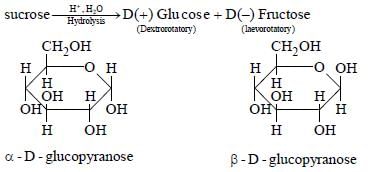JEE Exam > JEE Questions > Which of the following statements(s) is (are)...
Start Learning for Free
Which of the following statements(s) is (are) true ?
- a)Oxidation of glucose with bromine water gives glutamic acid
- b)The two six-membered cyclic hemiacetal forms of D-(+)-glucose are called anomers
- c)Monosaccharides cannot be hydrolysed to give polyhydroxy aldehydes and ketones
- d)Hydrolysis of sucrose gives dextrorotatory glucose and laevorotatory fructose
Correct answer is option 'B,C,D'. Can you explain this answer?
Verified Answer
Which of the following statements(s) is (are) true ?a)Oxidation of glu...

α-D-glucopyranose and β-D-glucopyranose are anomers of each other

|
Explore Courses for JEE exam
|

|
Which of the following statements(s) is (are) true ?a)Oxidation of glucose with bromine water gives glutamic acidb)The two six-membered cyclic hemiacetal forms of D-(+)-glucose are called anomersc)Monosaccharides cannot be hydrolysed to give polyhydroxy aldehydes and ketonesd)Hydrolysis of sucrose gives dextrorotatory glucose and laevorotatory fructoseCorrect answer is option 'B,C,D'. Can you explain this answer?
Question Description
Which of the following statements(s) is (are) true ?a)Oxidation of glucose with bromine water gives glutamic acidb)The two six-membered cyclic hemiacetal forms of D-(+)-glucose are called anomersc)Monosaccharides cannot be hydrolysed to give polyhydroxy aldehydes and ketonesd)Hydrolysis of sucrose gives dextrorotatory glucose and laevorotatory fructoseCorrect answer is option 'B,C,D'. Can you explain this answer? for JEE 2025 is part of JEE preparation. The Question and answers have been prepared according to the JEE exam syllabus. Information about Which of the following statements(s) is (are) true ?a)Oxidation of glucose with bromine water gives glutamic acidb)The two six-membered cyclic hemiacetal forms of D-(+)-glucose are called anomersc)Monosaccharides cannot be hydrolysed to give polyhydroxy aldehydes and ketonesd)Hydrolysis of sucrose gives dextrorotatory glucose and laevorotatory fructoseCorrect answer is option 'B,C,D'. Can you explain this answer? covers all topics & solutions for JEE 2025 Exam. Find important definitions, questions, meanings, examples, exercises and tests below for Which of the following statements(s) is (are) true ?a)Oxidation of glucose with bromine water gives glutamic acidb)The two six-membered cyclic hemiacetal forms of D-(+)-glucose are called anomersc)Monosaccharides cannot be hydrolysed to give polyhydroxy aldehydes and ketonesd)Hydrolysis of sucrose gives dextrorotatory glucose and laevorotatory fructoseCorrect answer is option 'B,C,D'. Can you explain this answer?.
Which of the following statements(s) is (are) true ?a)Oxidation of glucose with bromine water gives glutamic acidb)The two six-membered cyclic hemiacetal forms of D-(+)-glucose are called anomersc)Monosaccharides cannot be hydrolysed to give polyhydroxy aldehydes and ketonesd)Hydrolysis of sucrose gives dextrorotatory glucose and laevorotatory fructoseCorrect answer is option 'B,C,D'. Can you explain this answer? for JEE 2025 is part of JEE preparation. The Question and answers have been prepared according to the JEE exam syllabus. Information about Which of the following statements(s) is (are) true ?a)Oxidation of glucose with bromine water gives glutamic acidb)The two six-membered cyclic hemiacetal forms of D-(+)-glucose are called anomersc)Monosaccharides cannot be hydrolysed to give polyhydroxy aldehydes and ketonesd)Hydrolysis of sucrose gives dextrorotatory glucose and laevorotatory fructoseCorrect answer is option 'B,C,D'. Can you explain this answer? covers all topics & solutions for JEE 2025 Exam. Find important definitions, questions, meanings, examples, exercises and tests below for Which of the following statements(s) is (are) true ?a)Oxidation of glucose with bromine water gives glutamic acidb)The two six-membered cyclic hemiacetal forms of D-(+)-glucose are called anomersc)Monosaccharides cannot be hydrolysed to give polyhydroxy aldehydes and ketonesd)Hydrolysis of sucrose gives dextrorotatory glucose and laevorotatory fructoseCorrect answer is option 'B,C,D'. Can you explain this answer?.
Solutions for Which of the following statements(s) is (are) true ?a)Oxidation of glucose with bromine water gives glutamic acidb)The two six-membered cyclic hemiacetal forms of D-(+)-glucose are called anomersc)Monosaccharides cannot be hydrolysed to give polyhydroxy aldehydes and ketonesd)Hydrolysis of sucrose gives dextrorotatory glucose and laevorotatory fructoseCorrect answer is option 'B,C,D'. Can you explain this answer? in English & in Hindi are available as part of our courses for JEE.
Download more important topics, notes, lectures and mock test series for JEE Exam by signing up for free.
Here you can find the meaning of Which of the following statements(s) is (are) true ?a)Oxidation of glucose with bromine water gives glutamic acidb)The two six-membered cyclic hemiacetal forms of D-(+)-glucose are called anomersc)Monosaccharides cannot be hydrolysed to give polyhydroxy aldehydes and ketonesd)Hydrolysis of sucrose gives dextrorotatory glucose and laevorotatory fructoseCorrect answer is option 'B,C,D'. Can you explain this answer? defined & explained in the simplest way possible. Besides giving the explanation of
Which of the following statements(s) is (are) true ?a)Oxidation of glucose with bromine water gives glutamic acidb)The two six-membered cyclic hemiacetal forms of D-(+)-glucose are called anomersc)Monosaccharides cannot be hydrolysed to give polyhydroxy aldehydes and ketonesd)Hydrolysis of sucrose gives dextrorotatory glucose and laevorotatory fructoseCorrect answer is option 'B,C,D'. Can you explain this answer?, a detailed solution for Which of the following statements(s) is (are) true ?a)Oxidation of glucose with bromine water gives glutamic acidb)The two six-membered cyclic hemiacetal forms of D-(+)-glucose are called anomersc)Monosaccharides cannot be hydrolysed to give polyhydroxy aldehydes and ketonesd)Hydrolysis of sucrose gives dextrorotatory glucose and laevorotatory fructoseCorrect answer is option 'B,C,D'. Can you explain this answer? has been provided alongside types of Which of the following statements(s) is (are) true ?a)Oxidation of glucose with bromine water gives glutamic acidb)The two six-membered cyclic hemiacetal forms of D-(+)-glucose are called anomersc)Monosaccharides cannot be hydrolysed to give polyhydroxy aldehydes and ketonesd)Hydrolysis of sucrose gives dextrorotatory glucose and laevorotatory fructoseCorrect answer is option 'B,C,D'. Can you explain this answer? theory, EduRev gives you an
ample number of questions to practice Which of the following statements(s) is (are) true ?a)Oxidation of glucose with bromine water gives glutamic acidb)The two six-membered cyclic hemiacetal forms of D-(+)-glucose are called anomersc)Monosaccharides cannot be hydrolysed to give polyhydroxy aldehydes and ketonesd)Hydrolysis of sucrose gives dextrorotatory glucose and laevorotatory fructoseCorrect answer is option 'B,C,D'. Can you explain this answer? tests, examples and also practice JEE tests.

|
Explore Courses for JEE exam
|

|
Signup for Free!
Signup to see your scores go up within 7 days! Learn & Practice with 1000+ FREE Notes, Videos & Tests.






















